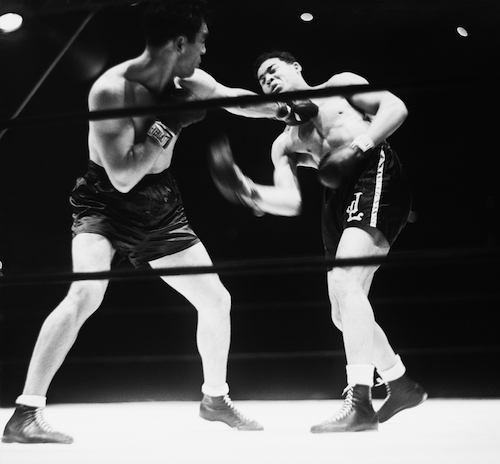Communiqué
The most politicized sporting event in history; “The Fight” on AMERICAN EXPERIENCE, Jan. 26 at 9 pm
< < Back toAmerican Experience The Fight
Thursday, January 26, 2023 at 9 pm
Film Explores the 1938 Heavyweight Championship Bout Between Joe Louis and German Max Schmeling
June 22, 1938. Though the Great Depression rages and war looms, the eyes of the world are on Yankee Stadium in New York where German Max Schmeling and American Joe Louis are squaring off for the heavyweight championship of the world. More than 90,000 people crowd the stadium to watch the encounter, and countless millions more around the world — the largest radio audience in history — listen to what one commentator would call “two minutes and four seconds of murder.” The Fight explores the 1938 heavyweight bout and finds two men who, in the shadow of war, became reluctant symbols of equality and supremacy, democracy and fascism. Written, directed and produced by Barak Goodman, co-produced by John Maggio, and narrated by Courtney Vance.
The pressure on each fighter is enormous. Louis is not only fighting for the honor of the country; he is quite literally holding the hopes of all African Americans. For Schmeling, the fight will be a demonstration of Hitler’s racial theories; should he lose, many fear what could happen to him. Theirs was a rivalry that would draw in two nations inching closer to war, and take the measure of two men who had been fighting all their lives.
“Often individuals become symbols of larger ideas and regimes. This was no less true in 1938, on the eve of World War II,” says Goodman. “On both sides of the Atlantic, Joe Louis and Max Schmeling came to personify two sides of a worldwide ideological struggle.”

Credit: Bettmann/Corbis
The son of Alabama sharecroppers, Louis rose to become the first crossover hero in American history, embraced by both blacks and whites. Born in 1914, he was in his early teens when his family left Alabama for Detroit, lured by the promise of $5 a day at the Ford factory. Pushing 200-pound truck bodies on a conveyor belt and hauling ice in the summer layered Joe’s lean physique with muscle. Boxing promised Louis not only a way to escape poverty, it was a way to reinvent himself — to leave behind the kid from the cotton fields and become the fast, fearsome fighter.
He soon caught the eye of two big-city racketeers, John Roxborough and Julian Black, who became his managers. Together with a tough ex-con named Jack Blackburn who signed on as trainer, the team set out to make Louis the second black heavyweight champion ever. To do this, they had to overcome the legacy of the first, the controversial Jack Johnson. Historian Jeffrey Sammons recalls that Louis “could not gloat over opponents, could not be seen in public with white women. He had to be seen as Bible-reading, mother-loving, God-fearing . . . and not be too black.”
Max Schmeling, too, was adept at disguise. The son of a working-class sailor, Schmeling had discovered boxing in his hometown, Hamburg. The penniless 20-year-old arrived in Berlin in 1926. There his talent caught the eye of Germany’s leading boxing writer, Arthur Bulow, who became his manager. Schmeling rose quickly, becoming first German, then European champion. His rise was followed avidly by Berlin’s predominantly Jewish avant-garde, who had fallen in love with boxing. Max took to the strange world as if he had been born to it, and within two years, the raw provincial boy was wearing tux and tails and attending the best parties. But when Hitler came to power in 1933, Schmeling dropped his former life and courted favor with the new regime.
The two fighters met for the first time in Yankee Stadium in 1936. Louis, whose rise to the top of the heavyweight ranks was accomplished with unprecedented speed and brilliance, was the prohibitive favorite, so much so that not even the Nazi government thought Schmeling, with an up-and-down career in the ring, had a chance. Only Max himself was confident, believing that he had spotted a tiny flaw in Louis’ overwhelming attack.
The fight was even through three rounds, but in the fourth Schmeling saw his opening and struck Louis with a devastating overhand right. At that moment, Schmeling would later say, Louis changed from an indestructible force to “a hurt and bewildered boy.” Finally, in the 12th round, the punishment became too much.
Louis’ loss was crushing to African Americans, who had come to regard him as the only black man who could meet and defeat whites on equal terms. The victory thrust Schmeling into the awkward role of Hitler’s favorite boxer. “He was loyal to his government,” sports journalist Volker Kluge says of Schmeling. “But this loyalty came at a price. He had to burden his conscience with the dark sides of the regime: the dictatorship, the camps, the persecutions, the discrimination.”
A rematch was scheduled for June 1938. By this time, Hitler’s intentions were clear and Schmeling, once popular in America, had become the hated symbol of Nazi aggression. Meanwhile, Louis was elevated to the role of standard-bearer for American democracy, despite the fact that blacks were still often blocked at the voting booths, and couldn’t fully share in the freedoms enjoyed by whites.
The Fight climaxes with the recounting of this most famous of heavyweight bouts.

